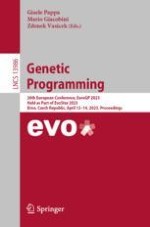This book constitutes the refereed proceedings of the 26th European Conference on Genetic Programming, EuroGP 2023, held as part of EvoStar 2023, in Brno, Czech Republic, during April 12–14, 2023, and co-located with the EvoStar events, EvoCOP, EvoMUSART, and EvoApplications.
The 14 revised full papers and 8 short papers presented in this book were carefully reviewed and selected from 38 submissions. The wide range of topics in this volume reflects the current state of research in the field. The collection of papers cover topics including developing new variants of GP algorithms for both optimization and machine learning problems as well as exploring GP to address complex real-world problems.
